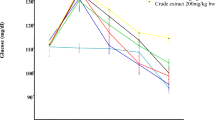Abstract
Aim is to study the antidiabetic effect of a compound GII purified earlier from the water extract of fenugreek (Trigonella foenum graecum) seeds by Murthy and his colleagues (patented in India and USA) in diabetic rabbits. Diabetes was induced in rabbits by injecting 80 mg/kg bw of alloxan intravenously into rabiits. Rabbits were subdivided into subdiabetic [fasting blood sugar (FBG) up to 120 mg/dl with abnormal glucose tolerance in glucose tolerance test (GTT)], moderately diabetic (FBG below 250 mg/dl) and severely diabetic (FBG above 250 mg/dl). Blood glucose and glycosylated hemoglobin (HbA1C) were estimated by procedures in the kits of Stangen Immunodiagnostics, Mumbai using, respectively, glucose oxidase method and absorbance at 415 nm. Serum insulin was estimated by the ELISA method as described in the kit of Boehringer Mannheim Immunodiagnostics, Mumbai, India. GII was found to improve blood glucose utilization in GTT and reduced FBG and HbA1C. In the present communication detailed studies were carried out with GII in the subdiabetic, moderately diabetic and severely diabetic rabbits. GII at a dose of 50 mg/kg bw per day brought down the elevated FBG levels in the untreated subdiabetic (FBG 96.6 ± 7 mg/dl), moderately diabetic (150.1 ± 14 mg/dl) and severely diabetic rabbits (427 ± 46 mg/dl) to normal in 12, 15 and 28 days of treatment. It improved serum HbA1C and insulin levels also in these rabbits. Intermittent therapy once a week for 6 weeks with GII at the same dose brought down the FBG values to normal in the subdiabetic (FBG 96.0 ± 2 mg/dl) and in the moderately diabetic rabbits to 133.0 ± 12 mg/dl. After stopping therapy of the subdiabetic and moderately diabetic rabbits whose FBG values came to normal after treatment with GII 50 mg/kg bw, the values remained normal for 1 week and showed a tendency to increase only after 15 days. If these animal studies are applicable to humans these results indicate that a diabetic person need not take GII daily when once the FBG value comes to normal or near to normal. Patients might be able to take GII only when the FBG value shows tendency to increase. So, intermittent therapy is possible with the potent product GII of the fenugreek seeds which is of a great advantage.
Similar content being viewed by others
References
Jung M, Park M, Lee HC, Kang YH, Kang ES, Kim SK. Antidiabetic agents from medicinal plants. Curr Trends Med Chem. 2006;13:1203–18.
Mukherjee PK, Maiti K, Mukherjee K, Houghton PJ. Leads from Indian medicinal plants with hypoglycemic potentials. J Ethnopharmacol. 2006;106:1–28.
Shani (Mishinsky) J, Joseph B, Sulman FJ, Goldschmied A. Hypoglycaemic effect of trigonelline. Lancet. 1967;16:1311–2.
Moorthy Radha, Prabhu KM, Murthy PS. Studies on the isolation and effect of an orally active hypoglycemic principle from the seeds of fenugreek (Trigonella foenum graecum). Diabetes Bull. 1989;9:69–72.
Moorthy R, Prabhu KM, Murthy PS. Anti-hyperglycemic compound GII from fenugreek (Trigonella foenum-graceum Linn) seeds, its purification and effect in diabetes mellitus. Ind J Exp Biol. 2010;48:1111–1118.
Babu BV, Moorthy Radha, Pugazhenthi S, Prabhu KM, Murthy PS. Alloxan recovered rabbits as animal models for screening the hypoglycemic activity of compounds. Indian J Biochem Biophys. 1988;25:714–8.
Murali YK, Chandra Ramesh, Murthy PS. Antihyperglycemic effect of water extract of dry fruits of Terminalia chebula in experimental diabetes mellitus. Indian J Clin Biochem. 2004;19(2):202–4.
Gupta RK, Kesari AN, Watal G, Murthy PS, Chandra Ramesh, Maithal K, Tandon V. Hypoglycaemic and antidiabetic effect of aqueous extract of leaves of Annona squamosa (L) in experimental animal. Curr Sci. 2005;88(8):1244–54.
Modak M, Dixit P, Londhe J, Ghaskabdi S, Devasagayam TP. Indian herbs and herbal drugs used for the treatment of diabetes. J Clin Biochem Nutr. 2007;40:163–73.
Author information
Authors and Affiliations
Corresponding author
Rights and permissions
About this article
Cite this article
Puri, D., Prabhu, K.M. & Murthy, P.S. Antidiabetic Effect of GII Compound Purified from Fenugreek (Trigonella foenum graecum Linn) Seeds in Diabetic Rabbits. Ind J Clin Biochem 27, 21–27 (2012). https://doi.org/10.1007/s12291-011-0151-1
Received:
Accepted:
Published:
Issue Date:
DOI: https://doi.org/10.1007/s12291-011-0151-1



